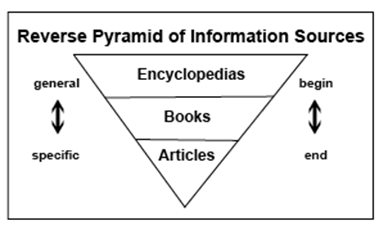
Understanding the form of some major types of academic publications will help your research:
 So, what type of publication should you start with? Follow the “reverse pyramid” method. Start with the most general information and then move on to publications that tend to be more specific. This usually means starting with a quick reference tool like an encyclopedia to get an overview of your topic, then going on to more in-depth books, and finally getting to the more specific (and likely more technical) journal articles last. The publications listed above can be found by using various search tools—databases on the UNB Libraries’ website which let you discover different types of publications. Try a Subject Guide for your research area, which will direct you to librarian-recommended tools and other information sources.
So, what type of publication should you start with? Follow the “reverse pyramid” method. Start with the most general information and then move on to publications that tend to be more specific. This usually means starting with a quick reference tool like an encyclopedia to get an overview of your topic, then going on to more in-depth books, and finally getting to the more specific (and likely more technical) journal articles last. The publications listed above can be found by using various search tools—databases on the UNB Libraries’ website which let you discover different types of publications. Try a Subject Guide for your research area, which will direct you to librarian-recommended tools and other information sources.An important part of gathering and evaluating sources for research projects is knowing the difference between scholarly, popular, and trade publications.
The physical appearance of print sources can help you identify the type of source as well. Scholarly journals are usually smaller and thicker with plain covers and images. Popular magazines and trade publications are usually glossy with many photos. In electronic sources you can check for bibliographies and author credentials or affiliations as potential indicators of scholarly sources.
|
Scholarly (including peer-reviewed) |
Trade Publications |
Popular Magazines |
|
|
Content |
Research results/ reports; reviews of research (review articles); book reviews |
Articles about a certain business or industry |
Current events; general interest articles |
|
Purpose |
To share research or scholarship with the academic community |
To inform about business or industry news, trends, or products |
To inform, entertain, or elicit an emotional response |
|
Author |
Scholars/researchers |
Staff writers, business/industry professionals |
Staff writers, journalists, freelancers |
|
Audience |
Scholars, researchers, students |
Business/industry professionals |
General public |
|
Review |
Editorial board made up of other scholars and researchers. Some articles are peer-reviewed |
Staff editor |
Staff editor |
|
Citations |
Bibliographies, references, endnotes, footnotes |
Few, may or may not have any |
May not have citations, or may be informal (ex. according to... or links) |
|
Frequency |
Quarterly or semi-annually |
Weekly/monthly |
Weekly/monthly |
|
Ads* |
Minimal, usually only for scholarly products like books |
Ads are for products geared toward specific industry |
Numerous ads for a variety of products |
|
|
Information from Barry University Research Guide. |